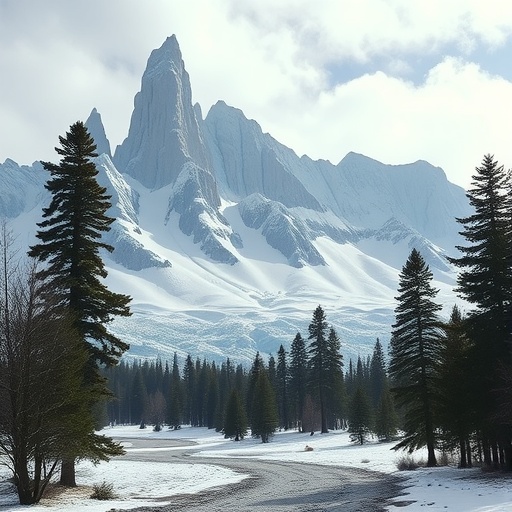A comprehensive new study offers groundbreaking insights into the evolutionary trajectory of cold-adapted species such as the woolly mammoth, musk ox, and arctic fox, shedding light on how these iconic animals developed survival mechanisms tailored to the harsh climates of the ice age. By integrating fossil records with cutting-edge paleogenetic analysis, a team of leading paleontologists and paleogeneticists has unveiled a clearer timeline for the emergence and adaptation of flora and fauna in the frigid environments of the Northern Hemisphere, tracing evolutionary landmarks that span over two million years.
This research rigorously examined the interplay between climatic fluctuations and species evolution, focusing on the Pleistocene epoch—characterized by oscillating glacial periods and expansive ice sheets. The team’s analyses indicate that truly cold-adapted animals began to emerge approximately 2.6 million years ago, coinciding with the relentless expansion of permanent polar ice caps. This environmental transformation created new ecological niches driving evolutionary differentiation among multiple lineages, many of which culminated in the iconic megafauna of the Late Pleistocene.
Following this initial evolutionary burst, the study pinpoints a critical interval around 700,000 years ago when glacial cycles intensified, with cold phases increasing in duration and severity. This shift appears to have catalyzed a second wave of evolutionary specialization, coinciding temporally with the rise of several extant cold-adapted species alongside extinct taxa such as the woolly mammoth. The team’s synthesis of fossil morphology and ancient DNA sequences reveals distinct genetic adaptations that enhanced thermoregulation, metabolic efficiency, and behavioral strategies conducive to extreme cold survival.
Professor John Stewart of Bournemouth University, who spearheaded the investigation, emphasized the significance of this temporal framework: “Understanding when and how these cold-adapted species evolved is fundamental not only to reconstructing past ecosystems but also to assessing current vulnerabilities in the face of accelerating climate change.” Stewart highlights that many of these species remain highly sensitive to temperature fluctuations, underscoring the urgency for conservation measures informed by deep-time evolutionary perspectives.
Notably, the study delineated divergent evolutionary pathways within cold-adapted fauna. For instance, evidence suggests that early populations of true lemmings and reindeer may have originated within Arctic territories during the early Pleistocene, between one and two million years ago, adapting locally as climates progressively cooled. In contrast, species such as the polar bear and arctic fox appear to have a more recent evolutionary history, with genetic data supporting their colonization of the Arctic from southern refugia within the last 700,000 years, reflecting complex biogeographic dispersal patterns shaped by glacial dynamics.
Beyond mammals, this research challenges prevailing assumptions by integrating data on plants and invertebrates such as beetles. The comparative analyses demand a reevaluation of hypotheses positing earlier evolutionary onset for certain organisms in polar latitudes. Such findings suggest that the assemblage of modern Arctic ecosystems may be more recent and dynamic than previously believed, implicating intricate ecological interactions and community assembly processes that unfolded over the Quaternary period.
Another intriguing dimension arises from the study’s examination of cold-adapted megafauna like the woolly rhinoceros. Unlike strictly Arctic-origin species, the woolly rhino seems to have evolved within expansive steppe grasslands situated south of the main ice sheets, with fossil evidence pointing to origins in the Tibetan Plateau. This biogeographic nuance illustrates the complex mosaic of habitats contributing to cold-adapted biodiversity and highlights the role of high-altitude ecological zones as evolutionary crucibles during glacial intervals.
Methodologically, the research leverages a powerful combination of paleontological excavation, stratigraphic contextualization, and high-resolution paleogenomic sequencing—techniques that have only recently become feasible with advances in DNA retrieval from permafrost and sediment samples. Statistical modeling and comparative phylogenetic frameworks enabled the team to resolve chronological uncertainties and infer adaptive trait evolution with unprecedented precision, marking the first concerted effort to directly compare cold-adapted animals and plants using integrated paleogenetic data.
The implications extend beyond reconstructing ice age biotas. By delineating the tempo and mode of cold adaptation, this work provides essential context for interpreting ongoing ecological shifts in polar regions, where warming climates threaten the persistence of specialized species. Understanding the evolutionary resilience and vulnerabilities of these organisms over millennia offers pivotal clues for contemporary conservation strategies aiming to mitigate biodiversity loss in Arctic and sub-Arctic habitats.
Importantly, this study invites a paradigm shift in how scientists view cold adaptation, proposing that the genesis of Arctic ecosystems is a protracted, multi-phase process driven by climatic oscillations rather than a singular, synchronous event. This nuanced interpretation reconciles disparate fossil and genetic records and calls attention to the dynamic evolutionary interplay between migration, local adaptation, and extinction across glacial cycles.
Looking forward, Professor Stewart advocates for expanded research deploying the latest paleogenetic methodologies to uncover additional layers of evolutionary history. By expanding taxonomic and geographic sampling, future studies may delineate further details of plant and animal responses to ancient climate shifts, refine models of ecosystem assembly, and elucidate the genetic basis of cold tolerance. Such insights will be invaluable for predicting species’ trajectories in an era of unprecedented anthropogenic environmental change.
In sum, this landmark study constitutes a major leap forward in paleobiology and evolutionary ecology by articulating a detailed chronology and mechanism of cold adaptation across multiple taxa. Its integrative approach sets a benchmark for future investigations at the nexus of paleontology, genetics, and climatology, fostering a deeper comprehension of life’s resilience in the face of Earth’s most extreme environments. Moreover, by contextualizing past evolutionary innovations, the research informs the urgent quest to safeguard Arctic biodiversity against the accelerating threats posed by global warming.
—
Article Title: The progressive evolution of cold-adapted species
News Publication Date: 22-May-2025
Web References: https://www.sciencedirect.com/science/article/pii/S0169534725000941
References: DOI: 10.1016/j.tree.2025.04.005
Keywords: Evolution, Evolutionary developmental biology, Evolutionary ecology, Paleontology, Ecology, Evolutionary genetics, Evolutionary theories, Earth age, Geologic periods, Ice ages




